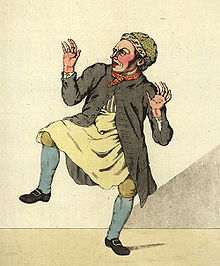The citizens of Vienna
| Data | |
|---|---|
| Title: | The citizens of Vienna |
| Genus: | Local farce in three acts |
| Original language: | German |
| Author: | Adolf Bäuerle |
| Publishing year: | 1813 |
| Premiere: | October 23, 1813 |
| Place of premiere: | Theater in the Leopoldstadt |
| Place and time of the action: | The piece takes place in Leopoldstadt and on the Danube under the white tanners in Vienna |
| people | |
|
|
Die Bürger in Wien is a local farce in three acts by Adolf Bäuerle . The first performance took place on October 23, 1813 in the Vienna Theater in Leopoldstadt .
content
Both the rich businessman Müller and the poet Karl Berg court the hand of Käthchen, who already loves the poet. The father Josef Redlich doesn't like either of them to be his son-in-law, Berg because of his poverty, Müller because of the questionable origin of his wealth and because he wouldn't be a good patriot:
- "You are not a good person, not a good subject - you are a bad patriot." (Act 1, scene twelfth)
Mother Therese patronizes Müller, blinded by his wealth and the gifts for her and her daughter.
At the farewell party for Ferdinand, Käthchen's brother, who joins the soldiers, the citizens present attack Müller and throw him out. The vigilante commander Toloysky reminds everyone that they are now on guard duty at Franzensbrücke .
All the people involved try to engage the Parapluiemacher Staberl as a helper in the marriage affair and he promises everyone his support:
- "To be honest, it's all one to me, whether I smear him or her, that's tout megol for me, if only I had some of it!" (Second act, third scene)
Müller bribes Therese with an allegedly real diamond collar to persuade Käthchen to go on a boat trip with him. As the ship passes the Franzensbrücke, the citizens, including Karl, notice that Käthchen desperately defends herself against Müller's intrusiveness. She tears herself free and jumps into the water, Karl jumps after and saves her on the bank. While Müller escapes for the time being, Redlich gives up his resistance and agrees to Karl and Käthchen's engagement:
- "Let me act, I am a person and a father -" (third act, first scene)
The captured miller wants to bribe Staberl to let him go, but both he and Toloysky indignantly refuse. Then the engagement party is celebrated in Redlich's house and Staberl sings a self-composed song:
- “ That is why the song of praise sounds to the festival; We bring with gratitude:
- Long live the gracious guests! Long live the citizens of Vienna! " (Third act, twelfth scene)
Factory history
The play, which premiered in October 1813 in the Theater in der Leopoldstadt, was Bäuerle's first and at the same time greatest success as a playwright. The author owed this success for the most part to the actor who played Staberl, the actor Ignaz Schuster . The figure of Staberl as the successor to Hanswurst and Kasperl was the creation of Bäuerle. Staberl's constant phrase “If only I had some of it!” Became a household word in Vienna.
The author himself later wrote that the play was "to be regarded for nothing else than a Schwank, in which a thoroughly comical patron has to play the main role."
reception
According to Johann Sonnleitner, the Biedermeier cheerfulness of the piece carries
- “… Quite threatening and eerie features in themselves. Anyone who does not openly display their anti-French sentiments in the war of liberation and their loyalty to the ruling house will be excluded from the community of the bourgeois collective. "
Only Staberl differs from the penetrating honesty of the citizens, Bäuerle has put an end to the development of the Hanswurst with this funny figure . At the end of the 18th century, this stage design practically disappeared from the theater in its original form.
Helbig also states that the piece is a patriotic casual poem that only became so effective on the stage with the introduction of the Parapluimacher Staberl, who appeared here for the first time. This role soon became a standing figure in the Vienna Volkstheater and Bäuerle had to write four sequels - so-called “Staberliaden”. The success was based on the fact that Staberl, in contrast to his predecessors Hanswurst, Kasperl and Thaddädl, was not drawn like a template, but almost as a character figure.
literature
- Gerhard Helbig (ed.): The Viennese Volkstheater in its most beautiful pieces , Dieterich Collection Volume 253 (Bäuerle, Gleich, Meisl, Raimund, Nestroy), Dieterich'sche Verlagbuchhandlung in Leipzig 1960.
- Johann Sonnleitner (Ed.): Hanswurstiaden. A century of Viennese comedies. (Stranitzky, Kurz, Hafner, Perinet, Bäuerle), Residenz Verlag, Vienna / Salzburg 1996, ISBN 3-7017-1028-7 .
Web links
- Text in zeno.org
Individual evidence
- ↑ Negoziant = out of date for businessman, businessman
- ^ Sonnleitner: Hanswurstiaden. P. 277.
- ↑ tout megol = verballhornt from French tout égal matter
- ^ Sonnleitner: Hanswurstiaden. P. 287.
- ^ Sonnleitner: Hanswurstiaden. P. 311.
- ^ Sonnleitner: Hanswurstiaden. P. 329.
- ^ Helbig: The Vienna People's Theater in its Most Beautiful Plays , p. XXV.
- ^ Sonnleitner: Hanswurstiaden. Pp. 380-382.
- ^ Helbig: The Vienna People's Theater in Its Most Beautiful Plays , pp. XXIV – XXV.
